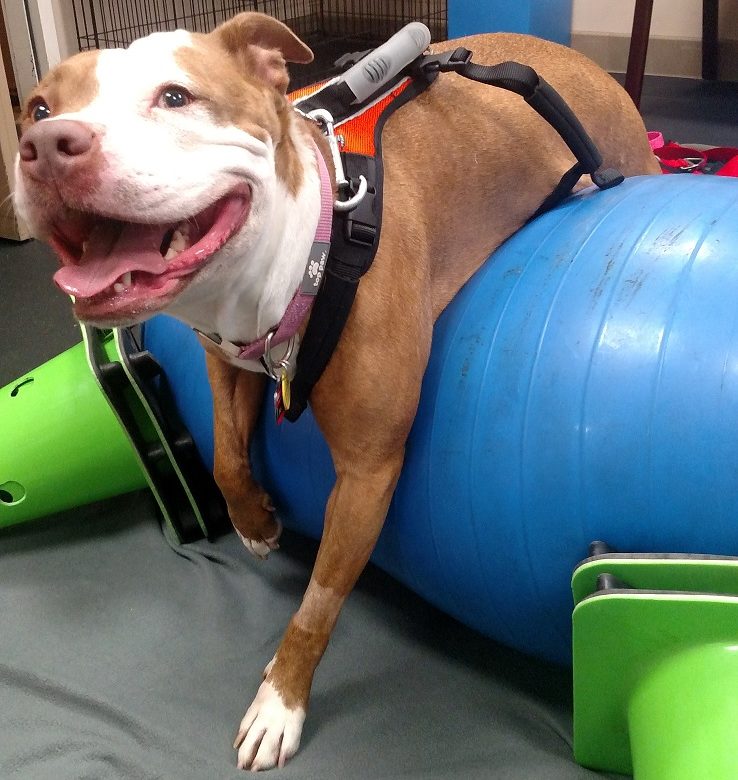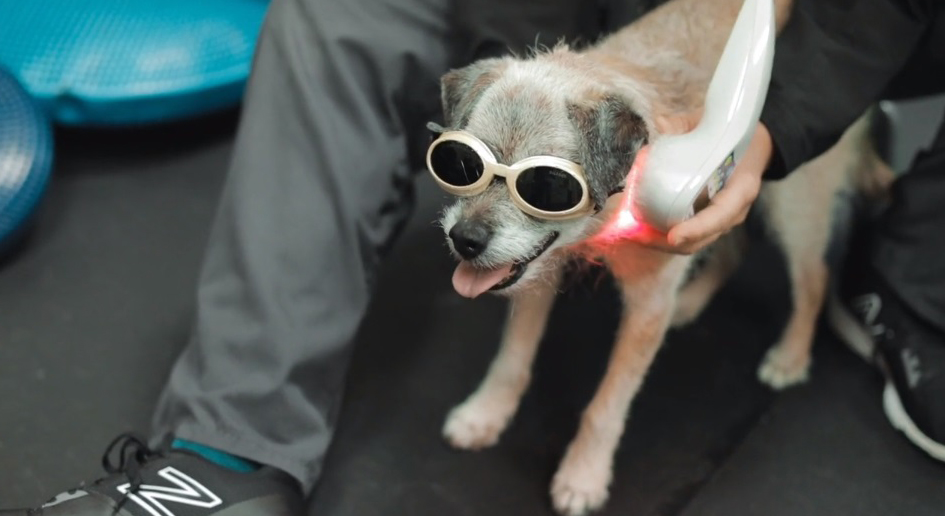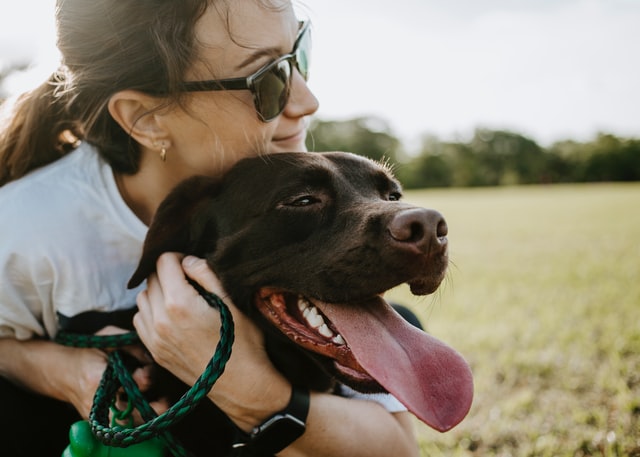Veterinary Rehabilitation
Physical rehabilitation can be extremely beneficial for various injuries and illnesses.
Helping your pet live its best life.
If your pet is suffering from an injury or illness related to the neurologic and musculoskeletal systems, physical rehabilitation can be extremely beneficial.
Rehabilitation services are vital to ensuring that your pet can eventually regain their comfortability in order to live a happy and healthy life. We can create and implement a rehabilitation plan for your pet to help them recover from an injury, manage a condition, and increase mobility.
Why would my pet need rehabilitation?
Most pet owners decide that veterinary rehabilitation is necessary for their pet after an injury or to manage their pet’s chronic health condition. It is important to note, however, that your pet does not need to be in any immediate pain to consider the benefits of rehabilitation services. Rehabilitation has been particularly useful in reducing and managing pain, improving athletic performance, treating injury, reducing the risk of further injury, restoring and maintaining movement and mobility, as well as improving the overall daily functions of your pet.
When should I consider rehabilitation for my pet?
If your pet is suffering from pain due to an injury or chronic health condition, rehabilitation may be the answer. Although pain-related symptoms are the most common indicators of a need for rehabilitation, if your pet is not living as comfortably as they could be, rehabilitation should be considered.
How does rehabilitation work?
Based on the condition of your pet, our veterinarians will create and implement a rehabilitation plan to restore mobility and eliminate any pain your pet may be feeling. We may recommend any of the following for rehabilitation treatment.
- Thermotherapy
- Electrode stimulation
- Exercise programs
- Massage
- Hydrotherapy
- Splinting
- Drug therapy
- Acupuncture
- Laser therapy
- Joint mobilization
- Spinal manipulative therapy
- Orthotics, prosthetics, or assistive devices
- Trigger point therapy
- Synovetin Osteoarthritis
- Shockwave treatments
- Therapeutic exercises
- Core strengthening
As your pet progresses, our team will keep careful records and make any necessary adjustments to ensure the rehabilitation process is successful. Pain medications can also be prescribed if necessary. With advanced equipment and progressive methodology, we dedicate ourselves to providing the best possible rehabilitation service for your dog, cat, or other animals. Every test, decision, and treatment is customized to the specific needs of your pet so that they can manage their condition or recovery and live out their happy, healthy life.
Veterinary Physical Therapy

Physical therapy can be extremely beneficial for your pet to help extend their quality of life, mobility, and comfort.
From athletes to senior pets, veterinary physical therapy can help animals with a diverse range of conditions. We can help create and implement a physical therapy plan for your pet to help extend their quality of life, mobility, and comfort.
Why would my pet need physical therapy?
Pet owners generally select physical therapy as a treatment option after an injury or to manage chronic health conditions such as obesity or arthritis.
When should I consider physical therapy for my pet?
Although most people seek out physical therapy for their pet after an injury or to manage a chronic health condition, your pet doesn’t have to be suffering to seek the benefits of physical therapy. If you are looking to improve or restore mobility, manage pain, treat an injury, or maximize physical potential, contact us to set up an exam.
How does physical therapy work?
Based on your pet’s condition, we will create a therapy plan for your pet. Some activities may include treadmill work, electrode stimulation, exercise programs, massage, hydrotherapy, orthotics, or assistive devices.
As therapy sessions progress, we will keep careful records and make adjustments as necessary to ensure progress is being made. We can also prescribe pain medications if necessary. With advanced equipment and progressive methodology, we are committed to providing the best possible physical therapy for your pet. Every test, decision, and treatment is customized to the specific needs of your pet so that they can manage their condition or recovery and live out their happy, healthy life.
Veterinary Laser Therapy

Laser therapy is a surgery-free, drug-free, and noninvasive treatment to reduce pain, reduce inflammation, and speed the healing process. Veterinary laser therapy has been scientifically proven to help treat post-surgical pain and many acute and chronic conditions.
Laser therapy uses a beam of light to deeply penetrate tissue, absorbing into the cell without damaging it and inducing a response called photobiomodulation, which helps reduce pain. While treating the affected area, the laser light generates a feeling of gentle and soothing warmth.
Why would my pet need laser therapy?
Therapy lasers are primarily used to reduce swelling, pain, and speed the healing process. These mechanisms allow us to successfully treat a wide range of conditions noninvasively and without drugs.
Studies indicate that laser-treated wounds heal in a third to a half of the time faster than the typical required healing time. Just a single laser treatment can reduce swelling and speed up the healing process post-surgery. Skin wounds, abrasions, bite injuries, dermatitis, and burns all respond well to laser therapy as well.
Our laser therapy uses a more modern and high-powered therapeutic laser that can deliver adequate dosages of laser energy (photons) painlessly and efficiently to deeper tissues. This laser is extremely beneficial in treating chronic conditions such as arthritis, hip dysplasia, back disease or injury, and degenerative joint diseases. This is a great therapy option for geriatric patients who suffer from one or more of these chronic painful conditions, as well as the aches and pains that come naturally with aging. There are many reports of pets returning to normal or almost normal function after laser therapy. More chronic and severe cases may require multiple treatment sessions to fully benefit.
When should I consider laser therapy for my pet?
Laser therapy can be useful for your pet in a number of ways. The following are common clinical conditions where veterinary laser therapy may be used as treatment.
- Musculoskeletal pain
- Immunoregulation
- Traumatic wound healing
- Surgical wound healing
- Increasing the metabolism of specific tissues
How does laser therapy work?
Treatment protocols are unique to each patient and condition, varying in time, complexity, and cost. Laser therapy can also be used to enhance other treatment plans we recommend.
Fortunately, laser therapy can be administered without touching the painful area, providing immediate pain relief and edema control to sensitive tissues. We also use therapeutic lasers to stimulate muscle and acupuncture points painlessly and without needles so your pet is as comfortable as possible. With advanced equipment and progressive methodology, we are committed to providing the best possible laser therapy for your furry friend. Every test, decision, and treatment is customized to the specific needs of your pet so that they can manage their condition or recovery and live out their happy, healthy life.
New Shock Wave Laser Therapy

What is the Shock Wave? (VersaTron4Paws high-energy sound wave technology)
Referred to as “shock wave” for more than a decade now, the VersaTron4Paws technology uses high-energy sound waves – called pulses or shock waves – to stimulate and speed the body’s own healing process. These sound waves release higher energy and result in deeper penetration than an ultrasound or laser, for example. The waves travel through soft tissue at different depths to a specific treatment area and begin healing.
How does it work?
The probe is held against the area of treatment for about 5 minutes per site. It can be somewhat uncomfortable, especially on painful areas such as an arthritic joint. However, most animals tolerate the treatment well without requiring sedation. Clipping the hair is typically not necessary either. The high-energy sound waves stimulate cells and release healing growth factors in the body that reduce inflammation and swelling, increase blood flow, help bones to heal, and enhance wound healing.
What can be treated with the VersaTron4Paws technology?
Backed by more than a decade of clinical research, shock wave can be used to reduce lameness, increase mobility, and relieve pain in dogs with:
- Osteoarthritis
- Tendon/ligament injuries
- Wounds
- Bone fractures
- Back Pain
- Shoulder Instability
Shock wave is noninvasive so it can be used in these conditions as an alternative to surgery, instead of increased non-steroidal pharmaceuticals, or as part of a rehab plan.
What can I expect from an average treatment?
An average treatment is relatively fast and easy, typically 10-15 minutes total, your vet will select the number of pulses for a specific area, apply the trode, and deliver the pulses in about 5 minutes.
What should I know and expect post-treatment?
It takes time for the biological responses in the body to take effect and begin healing. Your pet should not take part in any strenuous or high-impact activity during this period even if it appears it is feeling better. The healing is not complete, so give your pet some rest. Many times 1 treatment is sufficient for long-term healing, however, depending on the indication your veterinarian may recommend a second or third treatment a few weeks apart.
Email today to see if your pet may be a candidate for Shock Wave Treatments!
Veterinary Water Therapy
Water therapy can decrease recovery time from surgery, enhance cardiovascular fitness, and improve joint pain through low-impact exercise.
Water therapy, also known as hydrotherapy, utilizes an underwater treadmill. It provides an optimal rehabilitation setting by utilizing the warmth, buoyancy, and resistance of water. This form of therapy can decrease recovery time from surgery, enhance cardiovascular fitness, and improve joint pain through low impact exercise.
Why would my pet need water therapy?
Veterinary water therapy may be used for a number of reasons. It can simply be used to help keep a pet in shape during cold months or used as a treatment option for post-surgery recovery. Water therapy uses include:
- General exercise and fitness
- Weight loss
- Surgery recovery
- Joint work for arthritis
When should I consider water therapy for my pet?
Water therapy has a low impact on the joints and bones, making it a great outlet for post-surgery or post-trauma patients and pets with arthritic conditions to exercise, build endurance, and maintain muscle mass. Arthritic pets will have the ability to walk and move easier in an underwater treadmill, allowing for a better exercise than they would normally be able to achieve on the ground.
Overweight pets benefit from this type of exercise as they are able to work longer with less stress on their joints. Athletic pets who compete also benefit from this form of exercise, as it is a safer and quicker way to build stamina and muscle mass. If any of these qualities describe your pet, water therapy may be the right choice.
How does water therapy work?
We use warm water in the underwater treadmill during therapy to help relax and stretch the muscles and water jets to help stimulate circulation and further increase relaxation during a long exercise. To ensure progress and tailor the therapy to your pet’s needs, parameters need to carefully be adjusted per patient such as water depth, turbulence, speed, directions, and temperature. We will create a plan specifically for your cat, dog, or other animal and work with them to achieve their therapeutic goals.
With advanced equipment and progressive methodology, we are committed to providing the best possible water therapy for your pet. Every test, decision, and treatment is customized to the specific needs of your pet so that they can manage their condition or recovery and live out their happy, healthy life.
Veterinary Massage Therapy

Massage therapy focuses on restoring a pet’s mobility when dealing with discomfort related to aging, orthopedic issues, or sport-related injury.
Massage therapy is a form of treatment to help any pet that is dealing with minor pain and loss of mobility. Mobility can be negatively impacted by the aging process, orthopedic conditions, and sports-related injuries. Massage therapy seeks to restore both comfort and mobility by eliminating the negative effects of the aforementioned conditions.
Why would my pet need massage therapy?
Veterinary massage therapy could be beneficial to your pet for a number of reasons. This treatment is typically used to help combat both acute and chronic musculoskeletal injuries and can be used alongside other forms of treatment. If your pet is suffering from a recent injury, massage therapy could be used as a form of rehabilitation to help boost your pet’s mobility and stimulate healing in the affected areas.
When should I consider massage therapy for my pet?
If your pet is in noticeable discomfort or just not moving and enjoying life the way that they used to, then massage therapy for your pet might be worth considering. As a popular form of rehabilitation, this treatment has been used to combat orthopedic issues as well as sports-related injuries for the more athletic pet. Additionally, massage therapy has been used to help senior animals who are suffering from a loss of mobility, a natural occurrence of the aging process.
How does massage therapy work?
Your pet will be treated by a pet massage therapist who is educated on both your pet’s anatomy and their present physical condition. Therapy typically begins with the therapist performing a pain and mobility assessment. During this initial stage, the therapist will also feel for any abnormalities that could be impacting their condition. Once the condition of your pet has been properly assessed, the therapist will begin to treat your pet by massaging the affected areas of their body. The duration of treatment can vary depending on the condition of your pet. It is recommended for your pet to undergo a series of treatments in order to fully benefit and regain their mobility more effectively.
Our Rehabilitation Staff

Dr. Wiltzius
Associate Veterinarian

